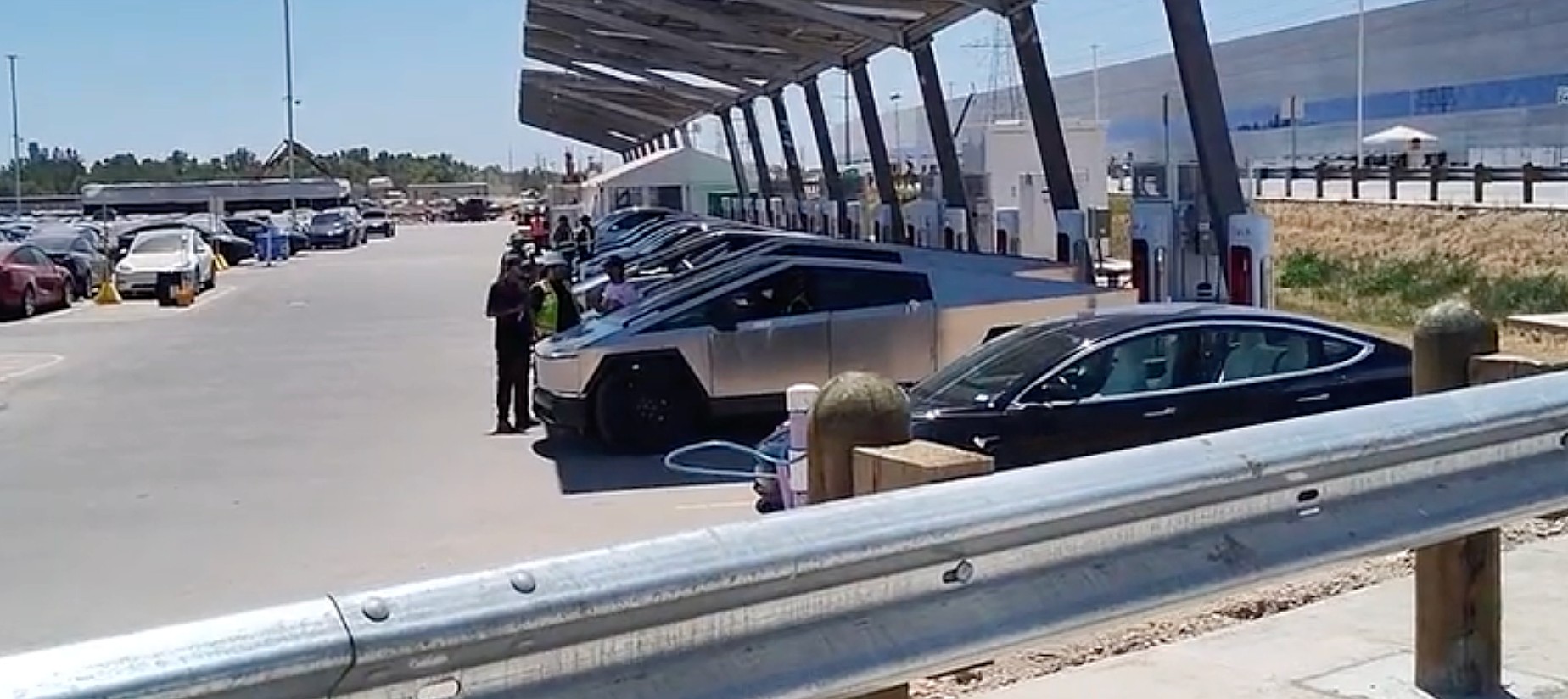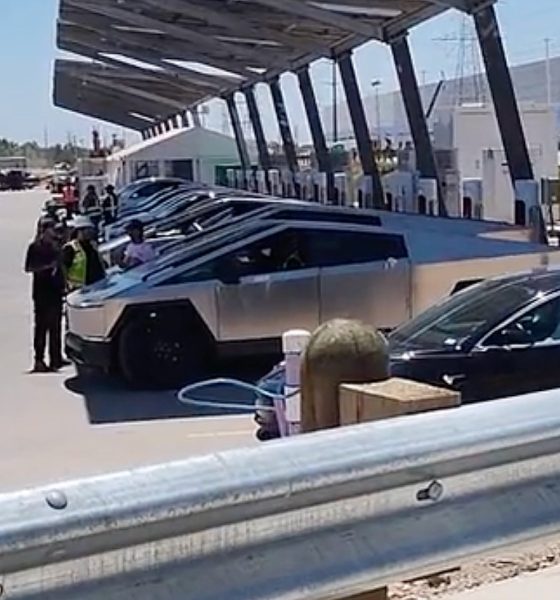

News
Tesla Cybertrucks Supercharging and crash testing point to imminent release
Tesla Cybertrucks are Supercharging in numbers at Giga Texas. A few units were spotted using the automaker’s electric vehicle chargers at the factory yesterday as the Cybertruck nears deliveries.
Earlier this month, a single Cybertruck was spotted at Giga Texas, using the factory’s Supercharger piles located on the property. It was the first instance of a Cybertruck being seen plugged into a Supercharger and gave us an additional look at the frunk of the vehicle, as an insert was spotted in the bed of the truck.
Tesla Cybertruck charging outside Gigafactory Texas shows interesting frunk detail
However, Cybertruck Supercharging is becoming a more popular occurrence at the Texas factory.
A new video from outside the walls of Tesla’s Austin-based production plant shows three units sitting plugged into Supercharger stalls.
NEW: 3 @Tesla Cybertrucks at the Giga Texas Superchargers! ?$TSLA @elonmusk
? by TikTok u/havefunworkhard pic.twitter.com/Tk7Ot9BBPy— S.E. Robinson, Jr. (@SERobinsonJr) August 18, 2023
Tesla could be performing simple analyses on the Cybertruck to determine its charging performance and could be checking to make sure everything internally with the pickup is normal, as these early units could be the first to make their way to customers.
We have been seeing an increase in sightings of Cybertrucks over the past few months. However, within the last few days, these sightings have become more interesting as nine Cybertruck units arrived at the Fremont Factory in Northern California yesterday.
Additionally, two crash-tested Cybertrucks were spotted in Northern California yesterday. Tesla operates its own crash testing facility within the Fremont property, but TRC California is also nearby, which is a facility commonly used by OEMs for crash testing.
Here’s TWO crash tested Cybertrucks ?
Look close and you see the crash tape as well as damage/ missing pieces!
These were in Hayward, CA. pic.twitter.com/BemTlmCw3G— Greggertruck (@greggertruck) August 18, 2023
Several days ago, Cybertruck units were also spotted heading northbound on I-55 in Missouri.
Two CyberTrucks heading NB on I-55 in SE Missouri. At the Steele weigh station. #Tesla #Cybertruck #tsla pic.twitter.com/EClqFa8GWU
— Coleslaw (@coleslaw_333) August 16, 2023
Interestingly, the National Highway Traffic Safety Administration (NHTSA) operates a crash testing facility in Ohio, which operates under the same TRC acronym (Transportation Research Center) as the California facility.
One of the three routes Google Maps selected would take the Cybertrucks up I-55 to get to TRC Ohio.
Credit: Google Maps
Perhaps crash testing is imminent for the Cybertruck, which would make it available for sale as long as the EPA has granted the all-electric pickup a certificate of conformity for operation on public roads.
The NHTSA and TRC have not yet responded to our inquiries for comment regarding potential crash testing for the Cybertruck.
I’d love to hear from you! If you have any comments, concerns, or questions, please email me at joey@teslarati.com. You can also reach me on Twitter @KlenderJoey, or if you have news tips, you can email us at tips@teslarati.com.

News
Tesla Model 3 named New Zealand’s best passenger car of 2025
Tesla flipped the switch on Full Self-Driving (Supervised) in September, turning every Model 3 and Model Y into New Zealand’s most advanced production car overnight.

The refreshed Tesla Model 3 has won the DRIVEN Car Guide AA Insurance NZ Car of the Year 2025 award in the Passenger Car category, beating all traditional and electric rivals.
Judges praised the all-electric sedan’s driving dynamics, value-packed EV tech, and the game-changing addition of Full Self-Driving (Supervised) that went live in New Zealand this September.
Why the Model 3 clinched the crown
DRIVEN admitted they were late to the “Highland” party because the updated sedan arrived in New Zealand as a 2024 model, just before the new Model Y stole the headlines. Yet two things forced a re-evaluation this year.
First, experiencing the new Model Y reminded testers how many big upgrades originated in the Model 3, such as the smoother ride, quieter cabin, ventilated seats, rear touchscreen, and stalk-less minimalist interior. Second, and far more importantly, Tesla flipped the switch on Full Self-Driving (Supervised) in September, turning every Model 3 and Model Y into New Zealand’s most advanced production car overnight.
FSD changes everything for Kiwi buyers
The publication called the entry-level rear-wheel-drive version “good to drive and represents a lot of EV technology for the money,” but highlighted that FSD elevates it into another league. “Make no mistake, despite the ‘Supervised’ bit in the name that requires you to remain ready to take control, it’s autonomous and very capable in some surprisingly tricky scenarios,” the review stated.
At NZ$11,400, FSD is far from cheap, but Tesla also offers FSD (Supervised) on a $159 monthly subscription, making the tech accessible without the full upfront investment. That’s a game-changer, as it allows users to access the company’s most advanced system without forking over a huge amount of money.
News
Tesla starts rolling out FSD V14.2.1 to AI4 vehicles including Cybertruck
FSD V14.2.1 was released just about a week after the initial FSD V14.2 update was rolled out.

It appears that the Tesla AI team burned the midnight oil, allowing them to release FSD V14.2.1 on Thanksgiving. The update has been reported by Tesla owners with AI4 vehicles, as well as Cybertruck owners.
For the Tesla AI team, at least, it appears that work really does not stop.
FSD V14.2.1
Initial posts about FSD V14.2.1 were shared by Tesla owners on social media platform X. As per the Tesla owners, V14.2.1 appears to be a point update that’s designed to polish the features and capacities that have been available in FSD V14. A look at the release notes for FSD V14.2.1, however, shows that an extra line has been added.
“Camera visibility can lead to increased attention monitoring sensitivity.”
Whether this could lead to more drivers being alerted to pay attention to the roads more remains to be seen. This would likely become evident as soon as the first batch of videos from Tesla owners who received V14.21 start sharing their first drive impressions of the update. Despite the update being released on Thanksgiving, it would not be surprising if first impressions videos of FSD V14.2.1 are shared today, just the same.
Rapid FSD releases
What is rather interesting and impressive is the fact that FSD V14.2.1 was released just about a week after the initial FSD V14.2 update was rolled out. This bodes well for Tesla’s FSD users, especially since CEO Elon Musk has stated in the past that the V14.2 series will be for “widespread use.”
FSD V14 has so far received numerous positive reviews from Tesla owners, with numerous drivers noting that the system now drives better than most human drivers because it is cautious, confident, and considerate at the same time. The only question now, really, is if the V14.2 series does make it to the company’s wide FSD fleet, which is still populated by numerous HW3 vehicles.
News
Waymo rider data hints that Tesla’s Cybercab strategy might be the smartest, after all
These observations all but validate Tesla’s controversial two-seat Cybercab strategy, which has caught a lot of criticism since it was unveiled last year.

Toyota Connected Europe designer Karim Dia Toubajie has highlighted a particular trend that became evident in Waymo’s Q3 2025 occupancy stats. As it turned out, 90% of the trips taken by the driverless taxis carried two or fewer passengers.
These observations all but validate Tesla’s controversial two-seat Cybercab strategy, which has caught a lot of criticism since it was unveiled last year.
Toyota designer observes a trend
Karim Dia Toubajie, Lead Product Designer (Sustainable Mobility) at Toyota Connected Europe, analyzed Waymo’s latest California Public Utilities Commission filings and posted the results on LinkedIn this week.
“90% of robotaxi trips have 2 or less passengers, so why are we using 5-seater vehicles?” Toubajie asked. He continued: “90% of trips have 2 or less people, 75% of trips have 1 or less people.” He accompanied his comments with a graphic showing Waymo’s occupancy rates, which showed 71% of trips having one passenger, 15% of trips having two passengers, 6% of trips having three passengers, 5% of trips having zero passengers, and only 3% of trips having four passengers.
The data excludes operational trips like depot runs or charging, though Toubajie pointed out that most of the time, Waymo’s massive self-driving taxis are really just transporting 1 or 2 people, at times even no passengers at all. “This means that most of the time, the vehicle being used significantly outweighs the needs of the trip,” the Toyota designer wrote in his post.
Cybercab suddenly looks perfectly sized
Toubajie gave a nod to Tesla’s approach. “The Tesla Cybercab announced in 2024, is a 2-seater robotaxi with a 50kWh battery but I still believe this is on the larger side of what’s required for most trips,” he wrote.
With Waymo’s own numbers now proving 90% of demand fits two seats or fewer, the wheel-less, lidar-free Cybercab now looks like the smartest play in the room. The Cybercab is designed to be easy to produce, with CEO Elon Musk commenting that its product line would resemble a consumer electronics factory more than an automotive plant. This means that the Cybercab could saturate the roads quickly once it is deployed.
While the Cybercab will likely take the lion’s share of Tesla’s ride-hailing passengers, the Model 3 sedan and Model Y crossover would be perfect for the remaining 9% of riders who require larger vehicles. This should be easy to implement for Tesla, as the Model Y and Model 3 are both mass-market vehicles.









